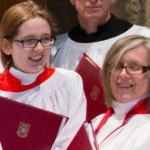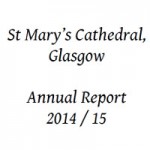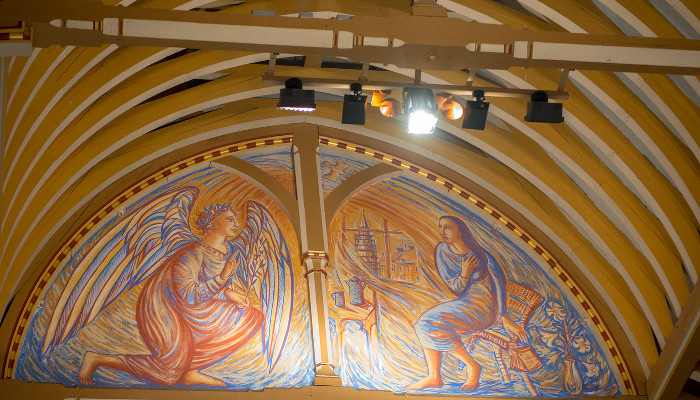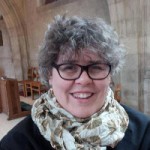In the June 1926 edition of the St Mary’s Magazine we may read a memoir written by a member of the then congregation, the 82-year-old John Spens, recalling the worship and liturgy of “Old St Mary’s”, the Renfield Street building which housed the congregation between 1825 and the opening of the current church in 1871. He ends his recollections with the caveat
“…with regard to the services and character of the buildings of the first St Mary’s it must be remembered that during the period of its existence there were…very different standards in our Church from those now in vogue.”
Were Mr Spens to attend one of the services today, what might strike him as familiar, if anything, and what would surprise and perhaps shock him? He would no doubt have arrived at 11 a.m. expecting the service of Matins, to be followed at 12.30 by Holy Communion. He might, as a distinguished lawyer and man of great rectitude have arrived promptly, but there is much evidence that the time-keeping of St Mary’s congregation was as wayward then as now. Having settled into a seat, although almost certainly not the pew which he had rented for the exclusive use of himself and his family, he might have mused on the relatively small congregation, as in his day St Mary’s could seat nearly 1,000 people and was usually filled to capacity. Visitors, or “strangers” as they were often described, were asked to wait until the service had started, and then shown to any unoccupied seats. Upon Mr Spens’ death in 1928 his customary position was marked by the elegant, Art Nouveau memorial still to be seen on the pillar next to which he sat for nearly sixty years.
Mr Spens might be less shocked by the current text of the Eucharist than we might expect, as a century ago St Mary’s was in the lead in accepting, indeed in promoting the many changes brought about by the introduction in 1912 of the Scottish Liturgy. The congregation and vestry – Mr Spens served as a vestryman for 54 years – expressed a desire for its use within a week of its authorisation by the Province to replace the use of the 1662 English Liturgy. While a few members of the congregation found the theological implications of the revised service to be unacceptably close to the espousal of Transubstantiation and left to find refuge in St Silas’, the majority continued to appreciate the richness of the services under the leadership of the then Provost, Frederic Llewellyn Deane.
Mr Deane, an energetic young man of formidable charm and well-developed people-skills, had during his tenure (1904-1917) introduced the use of liturgical colours, Eucharistic vestments, a sanctuary lamp and established the use of candles on the High Altar. These latter were initially only placed there for the 8.30 a.m. service, and removed before the later celebration, but gradually became generally accepted. Most of these innovations were explained in the monthly magazine, which will surely have defused much dissent. The 20th century change of focus from the High altar to a Nave Altar in the crossing, would have seemed outlandish to Mr Spens, but Mr Deane might have rejoiced in this as being in line with the aims of the Parish Communion Movement of the early 20th century, in its derivation from the practices of the Early Church bringing the people into the midst of the liturgy, rather than the medievalism of the Oxford Movement which rendered them passive and for the most part silent. In the Magazine of November 1906 Mr Deane pinned his colours to this mast in declaring
“Our Church makes its appeal to Scripture and the Primitive church; and [these both] teach us emphatically that the Eucharist is the chief act of Christian worship, the only service of Divine appointment, the only Gospel service, the only service obligatory upon all Christian people on the Lord’s Day in the Primitive Church”
Musically speaking, St Mary’s was living in interesting times too. The appointment in 1904 of George Pattman as Organist was an inspired choice, as much hard work lay ahead. The tenure of his predecessor William Green Martin had come slowly to a tragic end, as he had died in post of a brain tumour from which he had been suffering – in days before sickness benefit and free health care – for eight years. He was 47 years old, and had served St Mary’s since his appointment at the age of 22.
By 1904 efforts to have St Mary’s elevated to the status of Cathedral of the Diocese of Glasgow and Galloway were well advanced, and in all sorts of ways, physical, liturgical, and musical, standards had to be raised to meet this challenge. Mr Pattman, who had been apprenticed to Dr Haydn Keeton at Peterborough Cathedral, and had in the intervening years amassed significant experience in the churches of East Yorkshire and Humberside gaining a reputation as a successful choirmaster and trainer of boys’ voices. St Mary’s choir had, since the move to the Great Western Road building been a surpliced all male choir in the English Cathedral tradition, the gentlemen paid a small stipend varying according to length of service and experience, the boys given a free education at St Mary’s School in nearby Braid Street in lieu of payment. Mr Spens, however, will have remembered the choir at Old St Mary’s as being mixed; a “cock and hen” choir in the Scottish manner, unrobed and sitting in the West Gallery beside the organ, and so he might not be too alarmed by the present constitution of the choir, although the sight of women wearing surplices would have been startling to say the least. The scarlet of the cassocks worn by today’s musicians is different from the colour worn a century ago, as in preparation for “cathedralisation” – the term used in documents of 1908 – it was decided to change from the previous, unspecified colour to “bishops’ purple”, which was worn until the 1970s.
Compared with a century, even half a century ago, the modern congregational participation in the Ordinary of the Eucharist – the Gloria, Sanctus and Benedictus – would be a complete surprise to Mr Spens. In his later years the Eucharist was Choral every other week, alternating with a Choral Matins, and the Ordinary would have been sung by the choir to elaborate settings. Apart from the use of Gounod’s Messe Sollenelle every Easter, and until 1912 every Christmas, Whitsunday (Pentecost) and Dedication Festival, Latin Masses were not used, as they are occasionally today, but the norm was settings by English composers such as Martin, Stanford and Harwood of texts from the Book of Common Prayer. At the introduction of the Scottish Liturgy Mr Pattman adapted the Harwood setting to fit the Scottish use, and this was sung at Diocesan events.
The repertoire of anthems sung today would have been quite strange to our time-travelling visitor, as a century ago, although the number of anthems used was almost as great, they were far less varied, to a great extent limited to the style of the mid-19th century, to the works of Mendelssohn, Gounod and Spohr, and their weaker imitators. In this choice Mr Pattman shows the influence of his pupil-master Dr Haydn Keeton, of whom it was said by the conductor Sir Malcolm Sargent, one of his last apprentices, that
“Music stopped at Mendelssohn for him. He absolutely thought anything after Mendelssohn was very modern indeed…and he did not like it!”
Exceptions to this genre included the use in St Mary’s of Georgian verse anthems – anthems where most of the text was sung by a group of solo voices, by Purcell, Travers and Greene, giving the gentlemen the opportunity to shine – but also the use of anthems and excerpts from oratorios featuring the solo soprano voice, most notably the virtuoso aria “Let the bright seraphim” from Handel’s Samson, testifying to Mr Pattman’s skill as a trainer of boys’ voices. Neither of these genres is much in use today. In contrast, the range of evening Canticles was more varied in style. While some dreadful old 19th century warhorses such as Tours in F and Bunnet in A were still in the repertoire, some then contemporary examples still in use today were being added to join the classic Stanford settings, such as Brewer in D, Harwood in Ab, and Noble in Bm. Indeed it has recently been proved that some of the copies in use today date from Mr Pattman’s tenure as organist.
Although to modern ears the style of psalm-singing in the early years of the 20th century might seem hopelessly uncouth, the first part of each verse gabbled through and the last three words dragged out slowly and heavily, Mr Pattman and Provost Deane would probably be delighted to hear the current practice. Nowadays the aim is to replicate the manner of an intelligent reader delivering a text in a medium sized building such as St Mary’s, and colouring the words to underline their meaning. When Mr Pattman took up the post in 1904 he found the “gabble and thump” method of psalm singing well entrenched, thanks to the use in St Mary’s of The Cathedral Psalter of 1877 which encouraged such attempts to fit the organic variety of lyrical prose into the severity of regular rhythm. In 1905 he recommended replacing this with the newly published Ripon Psalter, one of the earliest methods to foster a more natural speech rhythm, and members of the congregation were encouraged to purchase a copy for themselves, to improve their efforts to join in. in 1911 The St Mary’s Chant Book was published by Novello and Sons, comprised of a collection of favourite chants, and some composed by Mr Pattman himself. Some of these latter, notably daring for their day, have recently been restored to the Cathedral Choir’s repertoire.
In his later years Mr Pattman was to write
“[Provost Deane and I] were keen that the services [at St Mary’s] should be a pattern for what church services ought to be, and were somewhat in advance of our time in regard to speech rhythm in the Psalms.”
That is rather an understatement; our modern version of this, and the provision of a pointed text and harmonised chant the better to enable congregational participation, is still a rarity in churches where psalms are sung.
Perhaps the strongest indication of the theological, liturgical and musical differences between the St Mary’s of a century ago and the way we experience it now may be found in the early 20th century customs and practices surrounding Christmas. While nowadays Advent is a season of looking forward in expectation to the Incarnation, a hundred years ago it was a time of eschatological, apocalyptic dread as illustrated by the selection of anthems such as Remember now thy Creator by Steggall, Behold, all flesh is grass by Brahms, and In the hour of death by Kitson. There were no Carol Services as we know them now, just a few simple and mostly secular Christmas songs sung at a special children’s service on the afternoon of Christmas Eve. Christmas Day itself was a normal working day in Scotland, and the morning Eucharist, although splendid in its choice of music, had on a weekday to be timed to allow the gentlemen of the choir to “return to business” at mid-day. There would be no respite for the choir on Boxing Day, as regular daily Choral Evensong resumed on the 26th December.
It is often said that the practice of having a Watchnight Service on Hogmanay – there having been no similar Midnight Service on Christmas Eve – was to keep people out of the pub. However the choice of hymns for this service – they were always the same ones – would seem quite counterproductive in this respect. It can only be imagined how our modern congregation would respond to a service featuring such gems as
“Days and moments quickly flying/blend the living with the dead” (Hymn 289 from Hymns A&M)
Or
“A few more years shall roll,/ a few more seasons come,/ and we shall be with those/asleep within the tomb.” (A&M no 288)
A Happy New Year to you too!
When John Alexander Spens concluded his memoir of worship at Old St Mary’s with the caution that “…standards were very different from those now in vogue” he may have been justified. However, although styles may have changed through the last century, it seems that standards, in terms of a care for rich, thoughtful liturgy and a care for the best possible musical offering, were equally high then as now. When, many years later, George Pattman was asked to contribute to a posthumous biography of Frederic Llewellyn Deane, he summed up the relationship at the core of the first Golden Age thus;
“[Provost Deane’s] humanity, sympathetic understanding and wisdom made my life at St Mary’s a veritable bed of roses. Consequently I loved him and I loved the work there.”
As most church musicians would agree, this remains the Holy Grail of our profession, often sought, but rarely found.






